Constance
Forum Replies Created
-
ConstanceParticipant

 In making the second drawing, I used negative space, proportions, shadow/depth, watercolor (mixing colors, glazing, dry on dry for detail and texture. I am pleased with the improvement in proportions and detail--I never even noticed the different layers and the arrangement of the feathers before. I still want to work on the detail if the bird. And, despite the improvement, it still looks very two-dimensional. But overall, I am really happy with my improvement. in reply to: See How Far You’ve Come #662396
In making the second drawing, I used negative space, proportions, shadow/depth, watercolor (mixing colors, glazing, dry on dry for detail and texture. I am pleased with the improvement in proportions and detail--I never even noticed the different layers and the arrangement of the feathers before. I still want to work on the detail if the bird. And, despite the improvement, it still looks very two-dimensional. But overall, I am really happy with my improvement. in reply to: See How Far You’ve Come #662396 -
ConstanceParticipant
@Craig Yes,I am thinking of getting a finer point brush or using the Micron pen that was recommended for the course. I have tried to figure out the pencil line thing, too. I think they are just a guide for the water color, maybe? I definitely need to know more about technique.
in reply to: Filling Your Sketches with Color #662346 -
ConstanceParticipant
@Susan Thanks so much for the kind words!
in reply to: The Power of Comparison #662343 -
ConstanceParticipantYour sky is done so well! Is that wet on wet?in reply to: Filling Your Sketches with Color #660782
-
ConstanceParticipantDid you use glazing black over blue to darken the reflection on the water? Very effective! I also need to find a way to work more quickly; I have to work faster before it starts raining! I would like to get to where I am done in less than an hour, too. I wonder if it just takes practice or if there are tips for working more quickly.in reply to: Filling Your Sketches with Color #660781
-
ConstanceParticipantI like how you drew the detailed fur just at the edges of the body! Did you remove water from the brush to draw such detailed lines?in reply to: Filling Your Sketches with Color #660780
-
ConstanceParticipantIs your robin done with wet on wet technique? I really like how you layered the orange to show the contour on the robin.in reply to: Filling Your Sketches with Color #660779
-
ConstanceParticipant
 1)I do have trouble organizing my materials! At least, I have dedicated a bag for supplies so they are easy to grab. I would like to get a small board to clip everything to as a base for holding paint and my journal--artist friends have recommended that. 2)I think that one of the benefits of painting in the field is that it makes me slow down, listen, and think. For example, why are some ducks in breeding plumage now, but other duck species won't be in breeding plumage until much later? in reply to: Filling Your Sketches with Color #660778
1)I do have trouble organizing my materials! At least, I have dedicated a bag for supplies so they are easy to grab. I would like to get a small board to clip everything to as a base for holding paint and my journal--artist friends have recommended that. 2)I think that one of the benefits of painting in the field is that it makes me slow down, listen, and think. For example, why are some ducks in breeding plumage now, but other duck species won't be in breeding plumage until much later? in reply to: Filling Your Sketches with Color #660778 -
ConstanceParticipantGreat work! The sky is so dramatic. I also am impressed by how you showed the texture on the ice. I struggle with planning ahead to leave white where I need it This is so nice.in reply to: Getting Comfortable with Watercolor #657613
-
ConstanceParticipant
 This was my first watercolor since second grade. I thought by restricting my effort to one tree, it would be easy to mix a few shades of green. But there are so many shades of green in this Western Red Cedar and the low angle of the sun this time of year in Seattle added even more variation. I was able to mix a light gold for the side where the sun was hitting the tree, but I never got a dark enough green on the far side; I just kept getting black rather than the dark green I wanted. As far as technique, I had trouble transferring a sufficient amount of color to the plastic palette so I could mix up the amount of color I would need--I need to work on that, too. As far as patterns of color, I should have been more methodical and gone back to the first color lesson. I should have mixed a variety of tints, tones, and shades since this is all so new to me. But, it was really enjoyable and I learned so much. in reply to: Capturing Nature’s Color Palettes #655761
This was my first watercolor since second grade. I thought by restricting my effort to one tree, it would be easy to mix a few shades of green. But there are so many shades of green in this Western Red Cedar and the low angle of the sun this time of year in Seattle added even more variation. I was able to mix a light gold for the side where the sun was hitting the tree, but I never got a dark enough green on the far side; I just kept getting black rather than the dark green I wanted. As far as technique, I had trouble transferring a sufficient amount of color to the plastic palette so I could mix up the amount of color I would need--I need to work on that, too. As far as patterns of color, I should have been more methodical and gone back to the first color lesson. I should have mixed a variety of tints, tones, and shades since this is all so new to me. But, it was really enjoyable and I learned so much. in reply to: Capturing Nature’s Color Palettes #655761 -
ConstanceParticipant

 I revised the lizard picture from the timed gesture drawing exercise. I find that using proportions comes easily to me. But drawing negative space is still difficult. For example, I redrew that membrane that hangs down from the throat several times focusing on negative space and it is still not right. I also need to work more on breaking the object down into shapes; I think that would help me draw objects more quickly when I am observing live, moving animals. in reply to: Giving Your Drawings Depth #653304
I revised the lizard picture from the timed gesture drawing exercise. I find that using proportions comes easily to me. But drawing negative space is still difficult. For example, I redrew that membrane that hangs down from the throat several times focusing on negative space and it is still not right. I also need to work more on breaking the object down into shapes; I think that would help me draw objects more quickly when I am observing live, moving animals. in reply to: Giving Your Drawings Depth #653304 -
ConstanceParticipant
 This was difficult AND fun. I tried to draw the subject as a collection of shapes, and it worked out pretty well! I don't know how I judged the tail to be too short. I really tried to work with negative space and proportions. I'm pretty pleased with the results, as I am a beginning sketcher. in reply to: Drawing What You See – Upside Down Drawing #652634
This was difficult AND fun. I tried to draw the subject as a collection of shapes, and it worked out pretty well! I don't know how I judged the tail to be too short. I really tried to work with negative space and proportions. I'm pretty pleased with the results, as I am a beginning sketcher. in reply to: Drawing What You See – Upside Down Drawing #652634 -
ConstanceParticipant
 The use of proportions really helped in that I tend to get so interested in one aspect of the subject and make that aspect too big!. This forced me to keep that tendency under control. I focused first on relative proportions and then started using negative space, too. It was rewarding that they worked together.
I was able to use the proportion techniques on a still plant, but it takes me a long time. It will take a lot of practice before I can do this with a moving subject. in reply to: Getting the Proportions Right #649816
The use of proportions really helped in that I tend to get so interested in one aspect of the subject and make that aspect too big!. This forced me to keep that tendency under control. I focused first on relative proportions and then started using negative space, too. It was rewarding that they worked together.
I was able to use the proportion techniques on a still plant, but it takes me a long time. It will take a lot of practice before I can do this with a moving subject. in reply to: Getting the Proportions Right #649816 -
ConstanceParticipant
 I was surprised that I got better as I tried drawing more subjects. Did I concentrate better or did I learn to judge where my hand was on the paper? Interesting! In all of my sketches, I finish lower on the paper than where I started; I never finished higher on the page. I wonder why? Someone else commented ( and I agree) that this would be a good warm-up activity before sketching. in reply to: Focusing on Your Subject – Blind Contour Drawing #648598
I was surprised that I got better as I tried drawing more subjects. Did I concentrate better or did I learn to judge where my hand was on the paper? Interesting! In all of my sketches, I finish lower on the paper than where I started; I never finished higher on the page. I wonder why? Someone else commented ( and I agree) that this would be a good warm-up activity before sketching. in reply to: Focusing on Your Subject – Blind Contour Drawing #648598 -
ConstanceParticipantI really like how you zoomed in on your subjects; there 's so much to learn, even from a single yew needle! Your sketch really gives me a feel for how different the two types of needles are in texture. Your observations are great--I always forget to make comments on scent. Thank you for this!in reply to: The Power of Comparison #648416
-
ConstanceParticipantI am really taken by your close observations on these two seemingly simple objects. Your sketches really give me the "feel" of these two leaves and how different they are. Your observations are so good and so diverse--exposure to sunlight, leaf and bark texture, leaf margins, vein pattern. This made me realize that I should have narrowed my scope and made better observations on a smaller scale.in reply to: The Power of Comparison #648415
-
ConstanceParticipant
 1) I compared two plants on my deck. I am a beginner at sketching and it took me a lot of time. I enjoyed it so much but this did make me wonder how I can adapt my work for going out in the field--my goal for my nature journal. I know that practice will help me work more efficiently, but are there other things I can do to capture important points about the subjects in a shorter time period? Birds are not going to sit still for me.
I continue to be surprised by just how much more I observe when I draw. Drawing also gives me more time to think about questions I have. I have a biology background, so I think my observational skills are quite good. However, this study showed me just how much more I can grow in this regard.
2)This question of balance is key for me. When I finished drawing, I first thought I was done until I realized I had done no writing! Quantitative data is important, but asking questions led me to go back and do even more observations. I have an additional page or writing I didn't upload. In the earlier video on journal styles, one person had lots of boxes on her pages. I think this might be useful for me to use this more to force me to have a box for quantitative data, one for qualitative observations, one for questions , etc. in reply to: The Power of Comparison #648412
1) I compared two plants on my deck. I am a beginner at sketching and it took me a lot of time. I enjoyed it so much but this did make me wonder how I can adapt my work for going out in the field--my goal for my nature journal. I know that practice will help me work more efficiently, but are there other things I can do to capture important points about the subjects in a shorter time period? Birds are not going to sit still for me.
I continue to be surprised by just how much more I observe when I draw. Drawing also gives me more time to think about questions I have. I have a biology background, so I think my observational skills are quite good. However, this study showed me just how much more I can grow in this regard.
2)This question of balance is key for me. When I finished drawing, I first thought I was done until I realized I had done no writing! Quantitative data is important, but asking questions led me to go back and do even more observations. I have an additional page or writing I didn't upload. In the earlier video on journal styles, one person had lots of boxes on her pages. I think this might be useful for me to use this more to force me to have a box for quantitative data, one for qualitative observations, one for questions , etc. in reply to: The Power of Comparison #648412 -
ConstanceParticipant
 I didn't post my "Jump Right In" sketch originally. After Liz requested beginners submit their work, I got a bit of courage to post. I consider myself a real beginner. My last drawing was done about 50 years ago in my high school intro to art class! in reply to: Jump Right in! #648400
I didn't post my "Jump Right In" sketch originally. After Liz requested beginners submit their work, I got a bit of courage to post. I consider myself a real beginner. My last drawing was done about 50 years ago in my high school intro to art class! in reply to: Jump Right in! #648400 -
ConstanceParticipantExactly! That's my challenge, too.in reply to: Opening Your Senses #647872
-
ConstanceParticipantThis is really beautiful! You have great descriptions AND you have great sketches. I think it says that you spent 45 minutes on this? I would like to develop my skills enough to work this efficiently.in reply to: Opening Your Senses #647871
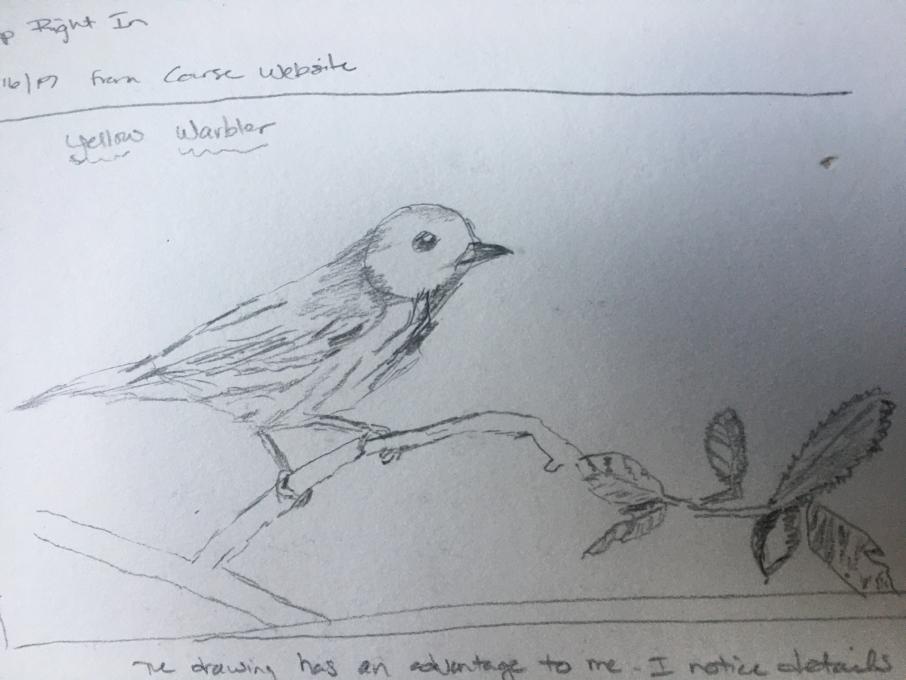
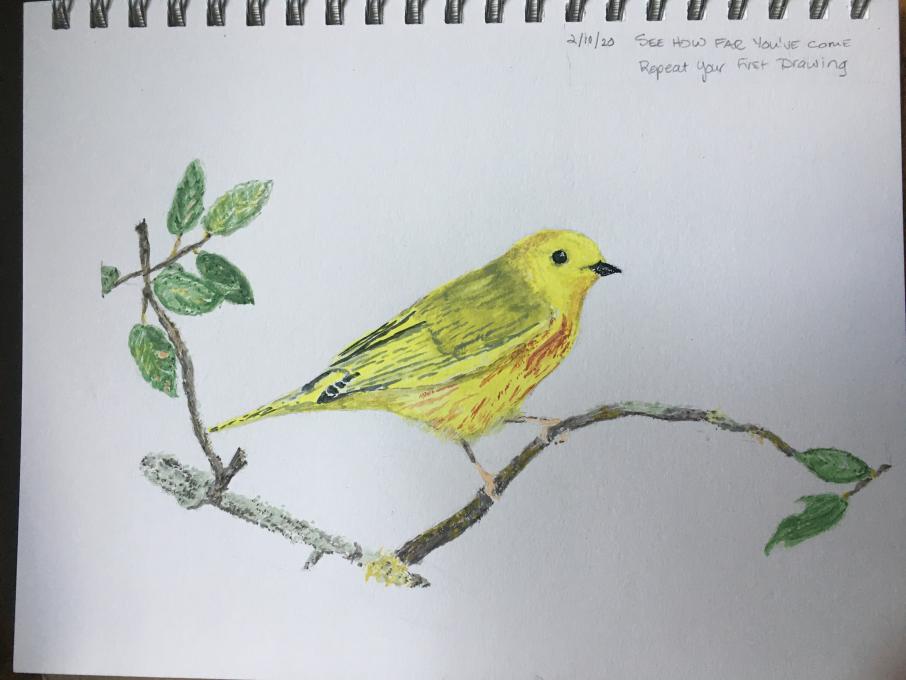 In making the second drawing, I used negative space, proportions, shadow/depth, watercolor (mixing colors, glazing, dry on dry for detail and texture. I am pleased with the improvement in proportions and detail--I never even noticed the different layers and the arrangement of the feathers before. I still want to work on the detail if the bird. And, despite the improvement, it still looks very two-dimensional. But overall, I am really happy with my improvement.
In making the second drawing, I used negative space, proportions, shadow/depth, watercolor (mixing colors, glazing, dry on dry for detail and texture. I am pleased with the improvement in proportions and detail--I never even noticed the different layers and the arrangement of the feathers before. I still want to work on the detail if the bird. And, despite the improvement, it still looks very two-dimensional. But overall, I am really happy with my improvement. 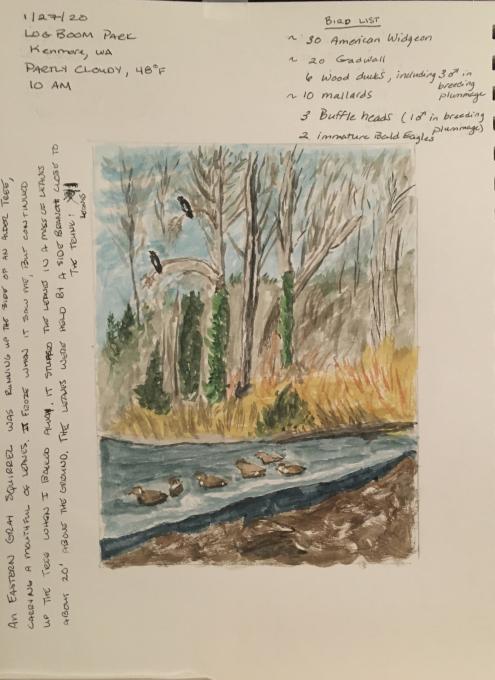 1)I do have trouble organizing my materials! At least, I have dedicated a bag for supplies so they are easy to grab. I would like to get a small board to clip everything to as a base for holding paint and my journal--artist friends have recommended that. 2)I think that one of the benefits of painting in the field is that it makes me slow down, listen, and think. For example, why are some ducks in breeding plumage now, but other duck species won't be in breeding plumage until much later?
1)I do have trouble organizing my materials! At least, I have dedicated a bag for supplies so they are easy to grab. I would like to get a small board to clip everything to as a base for holding paint and my journal--artist friends have recommended that. 2)I think that one of the benefits of painting in the field is that it makes me slow down, listen, and think. For example, why are some ducks in breeding plumage now, but other duck species won't be in breeding plumage until much later?  This was my first watercolor since second grade. I thought by restricting my effort to one tree, it would be easy to mix a few shades of green. But there are so many shades of green in this Western Red Cedar and the low angle of the sun this time of year in Seattle added even more variation. I was able to mix a light gold for the side where the sun was hitting the tree, but I never got a dark enough green on the far side; I just kept getting black rather than the dark green I wanted. As far as technique, I had trouble transferring a sufficient amount of color to the plastic palette so I could mix up the amount of color I would need--I need to work on that, too. As far as patterns of color, I should have been more methodical and gone back to the first color lesson. I should have mixed a variety of tints, tones, and shades since this is all so new to me. But, it was really enjoyable and I learned so much.
This was my first watercolor since second grade. I thought by restricting my effort to one tree, it would be easy to mix a few shades of green. But there are so many shades of green in this Western Red Cedar and the low angle of the sun this time of year in Seattle added even more variation. I was able to mix a light gold for the side where the sun was hitting the tree, but I never got a dark enough green on the far side; I just kept getting black rather than the dark green I wanted. As far as technique, I had trouble transferring a sufficient amount of color to the plastic palette so I could mix up the amount of color I would need--I need to work on that, too. As far as patterns of color, I should have been more methodical and gone back to the first color lesson. I should have mixed a variety of tints, tones, and shades since this is all so new to me. But, it was really enjoyable and I learned so much. 
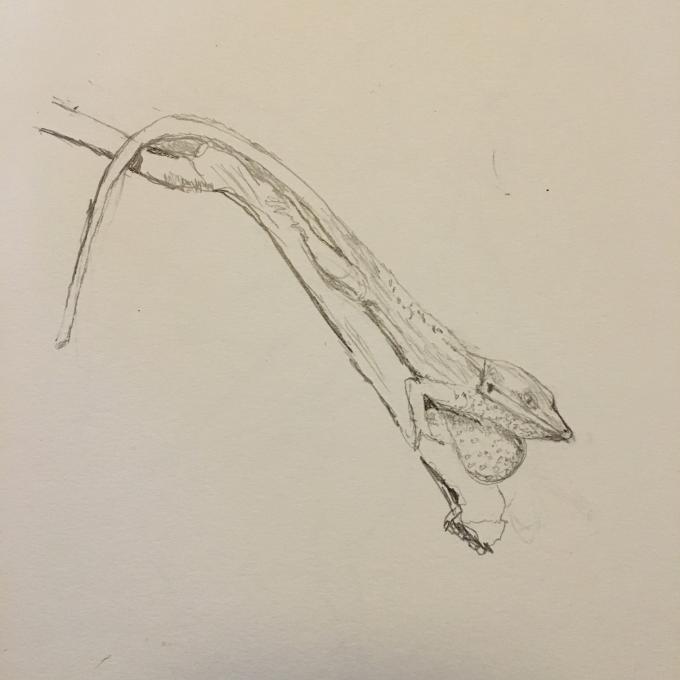 I revised the lizard picture from the timed gesture drawing exercise. I find that using proportions comes easily to me. But drawing negative space is still difficult. For example, I redrew that membrane that hangs down from the throat several times focusing on negative space and it is still not right. I also need to work more on breaking the object down into shapes; I think that would help me draw objects more quickly when I am observing live, moving animals.
I revised the lizard picture from the timed gesture drawing exercise. I find that using proportions comes easily to me. But drawing negative space is still difficult. For example, I redrew that membrane that hangs down from the throat several times focusing on negative space and it is still not right. I also need to work more on breaking the object down into shapes; I think that would help me draw objects more quickly when I am observing live, moving animals. 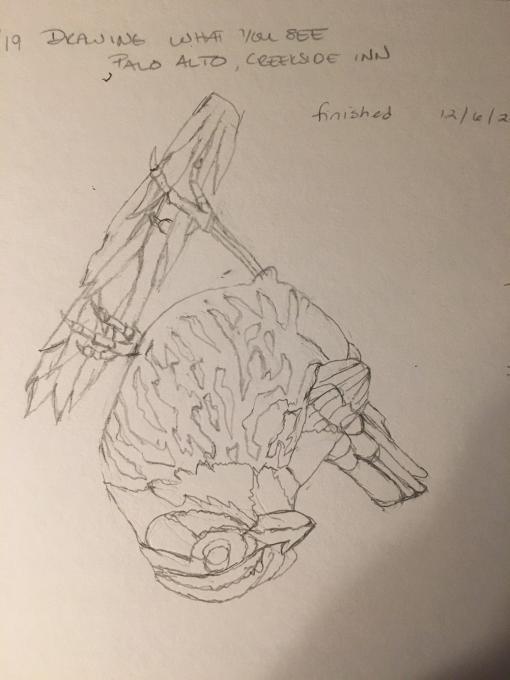 This was difficult AND fun. I tried to draw the subject as a collection of shapes, and it worked out pretty well! I don't know how I judged the tail to be too short. I really tried to work with negative space and proportions. I'm pretty pleased with the results, as I am a beginning sketcher.
This was difficult AND fun. I tried to draw the subject as a collection of shapes, and it worked out pretty well! I don't know how I judged the tail to be too short. I really tried to work with negative space and proportions. I'm pretty pleased with the results, as I am a beginning sketcher. 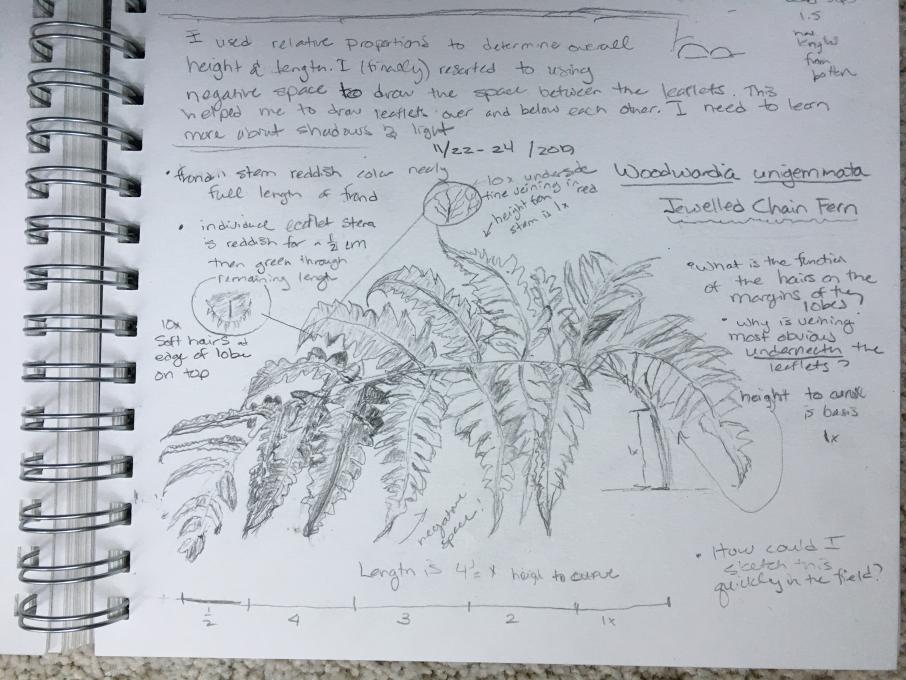 The use of proportions really helped in that I tend to get so interested in one aspect of the subject and make that aspect too big!. This forced me to keep that tendency under control. I focused first on relative proportions and then started using negative space, too. It was rewarding that they worked together.
I was able to use the proportion techniques on a still plant, but it takes me a long time. It will take a lot of practice before I can do this with a moving subject.
The use of proportions really helped in that I tend to get so interested in one aspect of the subject and make that aspect too big!. This forced me to keep that tendency under control. I focused first on relative proportions and then started using negative space, too. It was rewarding that they worked together.
I was able to use the proportion techniques on a still plant, but it takes me a long time. It will take a lot of practice before I can do this with a moving subject.  I was surprised that I got better as I tried drawing more subjects. Did I concentrate better or did I learn to judge where my hand was on the paper? Interesting! In all of my sketches, I finish lower on the paper than where I started; I never finished higher on the page. I wonder why? Someone else commented ( and I agree) that this would be a good warm-up activity before sketching.
I was surprised that I got better as I tried drawing more subjects. Did I concentrate better or did I learn to judge where my hand was on the paper? Interesting! In all of my sketches, I finish lower on the paper than where I started; I never finished higher on the page. I wonder why? Someone else commented ( and I agree) that this would be a good warm-up activity before sketching. 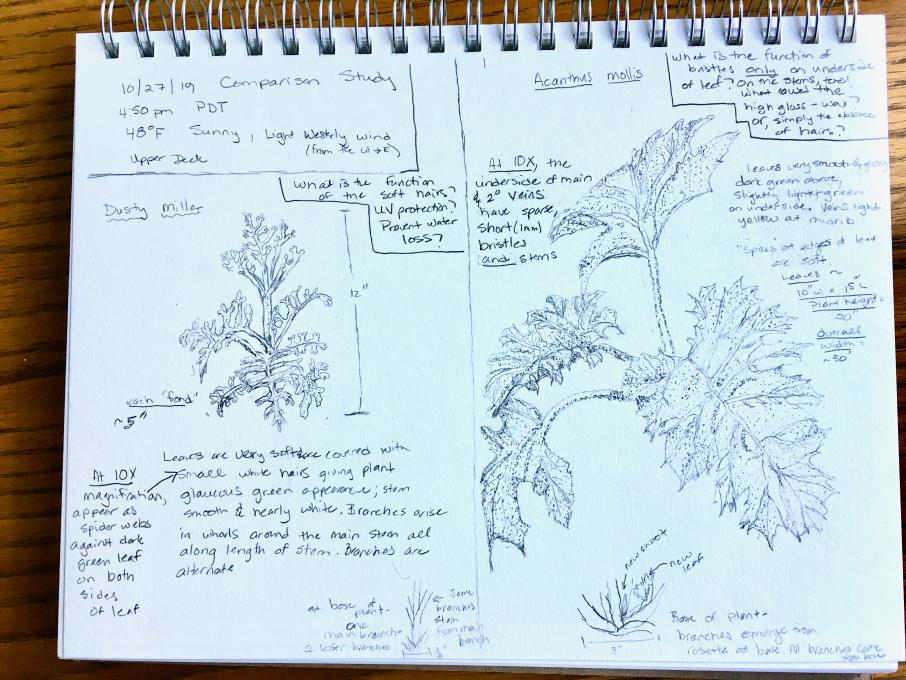 1) I compared two plants on my deck. I am a beginner at sketching and it took me a lot of time. I enjoyed it so much but this did make me wonder how I can adapt my work for going out in the field--my goal for my nature journal. I know that practice will help me work more efficiently, but are there other things I can do to capture important points about the subjects in a shorter time period? Birds are not going to sit still for me.
I continue to be surprised by just how much more I observe when I draw. Drawing also gives me more time to think about questions I have. I have a biology background, so I think my observational skills are quite good. However, this study showed me just how much more I can grow in this regard.
2)This question of balance is key for me. When I finished drawing, I first thought I was done until I realized I had done no writing! Quantitative data is important, but asking questions led me to go back and do even more observations. I have an additional page or writing I didn't upload. In the earlier video on journal styles, one person had lots of boxes on her pages. I think this might be useful for me to use this more to force me to have a box for quantitative data, one for qualitative observations, one for questions , etc.
1) I compared two plants on my deck. I am a beginner at sketching and it took me a lot of time. I enjoyed it so much but this did make me wonder how I can adapt my work for going out in the field--my goal for my nature journal. I know that practice will help me work more efficiently, but are there other things I can do to capture important points about the subjects in a shorter time period? Birds are not going to sit still for me.
I continue to be surprised by just how much more I observe when I draw. Drawing also gives me more time to think about questions I have. I have a biology background, so I think my observational skills are quite good. However, this study showed me just how much more I can grow in this regard.
2)This question of balance is key for me. When I finished drawing, I first thought I was done until I realized I had done no writing! Quantitative data is important, but asking questions led me to go back and do even more observations. I have an additional page or writing I didn't upload. In the earlier video on journal styles, one person had lots of boxes on her pages. I think this might be useful for me to use this more to force me to have a box for quantitative data, one for qualitative observations, one for questions , etc.  I didn't post my "Jump Right In" sketch originally. After Liz requested beginners submit their work, I got a bit of courage to post. I consider myself a real beginner. My last drawing was done about 50 years ago in my high school intro to art class!
I didn't post my "Jump Right In" sketch originally. After Liz requested beginners submit their work, I got a bit of courage to post. I consider myself a real beginner. My last drawing was done about 50 years ago in my high school intro to art class!